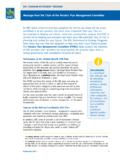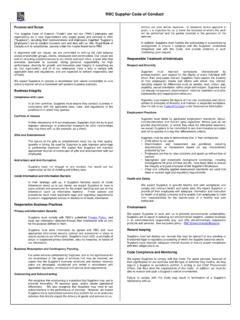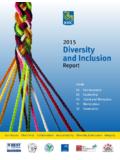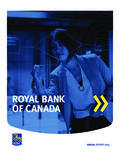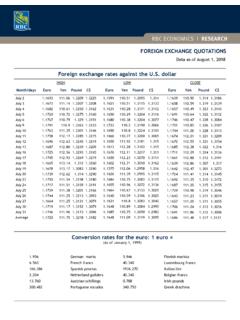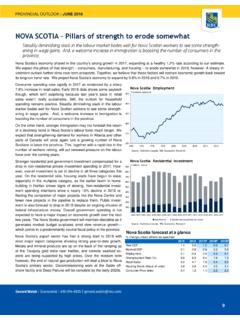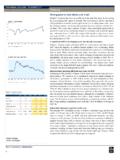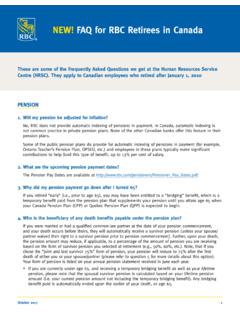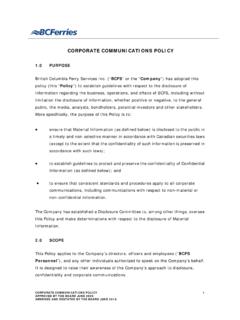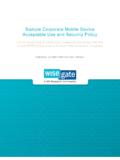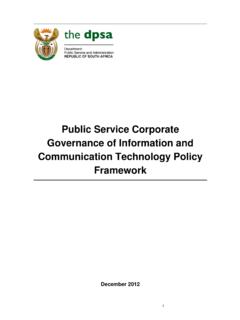Transcription of CORPORATE GOVERNANCE FRAMEWORK - RBC
1 CORPORATE GOVERNANCE FRAMEWORK March 2018 TABLE OF CONTENTS 1. INTRODUCTION .. 3 2. CORPORATE GOVERNANCE PRINCIPLES .. 3 3. GOVERNANCE STRUCTURE .. 5 4. THE BOARD S ROLE .. 5 5. COMMITTEES OF THE BOARD .. 6 Committee Chairs .. 6 Audit Committee .. 7 Risk Committee .. 7 GOVERNANCE Committee .. 7 Human Resources Committee .. 8 External advisors .. 8 6. MANAGEMENT S ROLE .. 8 Group Executive .. 8 Oversight functions .. 9 Reporting and escalation of significant issues to the Audit Committee and Risk Committee .. 9 Disclosure controls and certifications .. 9 7. BOARD COMPOSITION .. 10 Board size .. 10 Independence of the Board .. 10 Interlocking directorships .. 11 Evaluating candidates for the Board .. 11 Board diversity .. 12 Majority Voting Policy .. 12 Director tenure.
2 12 8. BOARD OPERATIONS .. 13 Non-executive Board Chair .. 13 Conflicts of interest .. 13 Meeting attendance .. 13 Director orientation and continuing education .. 14 Assessments of effectiveness .. 15 Board compensation .. 15 Shareholder engagement and 16 Interaction with regulators .. 16 Code of Conduct .. 16 9. APPROVAL, RESPONSIBILITY AND REVIEW SCHEDULE .. 16 3 1. INTRODUCTION This FRAMEWORK provides an overview of the CORPORATE GOVERNANCE structures, principles, policies and practices of the Board of Directors of Royal Bank of Canada (RBC or the Bank), which together enable RBC to meet GOVERNANCE expectations of the Office of the Superintendent of Financial Institutions Canada (OSFI), the Canadian Securities Administrators (CSA) and the Securities and Exchange Commission (SEC). To serve the interests of shareholders and other stakeholders, RBC s CORPORATE GOVERNANCE system is subject to ongoing review, assessment and improvement.
3 The Board of Directors proactively adopts GOVERNANCE policies and practices designed to align the interests of the Board and management with those of shareholders and other stakeholders and to promote the highest standards of ethical behaviour and risk management at every level of the organization. RBC Common Shares are listed on the Toronto Stock Exchange (TSX), the New York Stock Exchange (NYSE) and the Swiss Exchange. The Board exercises its authority in accordance with the RBC Code of Conduct, its By-laws and the Bank Act, as well as other applicable laws and regulations, including those imposed by the CSA, the TSX, the NYSE and the SEC. RBC s practices are consistent with Bank Act requirements, the OSFI Guideline on CORPORATE GOVERNANCE , the CSA s CORPORATE GOVERNANCE guidelines (CSA Guidelines) and the CSA s rules and applicable SEC rules relating to audit committees.
4 In addition, although RBC is not required to comply with most of the CORPORATE GOVERNANCE listing standards of the NYSE (NYSE Rules) applicable to domestic issuers, RBC meets or exceeds the NYSE Rules in all significant respects except as summarized on RBC s GOVERNANCE website. 2. CORPORATE GOVERNANCE PRINCIPLES RBC s approach to CORPORATE GOVERNANCE is guided by the following core principles: Principle Description Ethical Culture Trust, integrity and good GOVERNANCE are hallmarks of the Board s GOVERNANCE approach. By setting the tone from above, the Board champions the values of trust, integrity and good GOVERNANCE that are well entrenched in the culture of RBC, and reinforces the ethical principles on which RBC s reputation and success are founded. To maximize shareholder value on a sustainable basis, these values must extend into every segment of RBC operations and business activities.
5 Stewardship The members of the Board are the stewards of RBC, exercising independent judgment in overseeing management and safeguarding the interests of shareholders. In fulfilling its stewardship role, the Board seeks to instill and foster a CORPORATE environment founded on integrity and to provide management with sound guidance in pursuit of long-term shareholder value. CORPORATE GOVERNANCE FRAMEWORK 4 Principle Description Strategic Oversight The members of the Board are the key advisors to management, advising on strategic direction, objectives and action plans, taking into account both the opportunities and RBC s risk appetite. In carrying out this oversight role, the Board actively engages in setting the long term strategic goals for the organization, reviews and approves business strategies, CORPORATE financial objectives and financial and capital plans that are consistent with the strategic goals, and monitors RBC s performance in executing strategies and meeting objectives.
6 Risk Oversight The Board oversees the frameworks, policies and systems to identify and manage risks to the businesses and seeks to embed a strong risk management culture throughout RBC. The Board actively monitors the organization s risk profile relative to risk appetite and seeks to ensure that management s plans and activities provide an appropriate balance of return for the risks assumed and are prudently focused on generating shareholder value. Independence Independence from management is fundamental to the Board s effective oversight and mechanisms are in place to ensure its independence. All direct and indirect material relationships with RBC are considered in determining whether a member of the Board is independent. Accountability Transparency is a key component of good GOVERNANCE . The Board is committed to clear and comprehensive financial reporting and disclosure, and constructive shareholder engagement.
7 The Board has carefully defined the expectations and scope of duties of the Board, its committees and management. Continuous Improvement The Board is committed to continuous improvement of its CORPORATE GOVERNANCE principles, policies and practices, which are designed to align the interests of the Board and management with those of shareholders, to support the stewardship role of the Board and to enhance the Board s ability to safeguard the interests of shareholders through independent supervision of management. To ensure policies and practices meet or exceed evolving best practices and regulatory expectations, RBC s CORPORATE GOVERNANCE system is subject to ongoing review by the GOVERNANCE Committee of the Board. CORPORATE GOVERNANCE FRAMEWORK 5 3. GOVERNANCE STRUCTURE The fundamental relationships among the Board, its committees, management, shareholders and other stakeholders are established by RBC s GOVERNANCE structure, illustrated below, through which its ethical values and strategic and CORPORATE objectives are set, and plans for achieving those objectives and monitoring performance are determined.
8 4. THE BOARD S ROLE The Board is responsible for the overall stewardship of RBC. Directors are elected by the shareholders to supervise management of the business and affairs of the organization with the goal of enhancing long-term shareholder value. The Board s role consists of two fundamental elements: decision-making and oversight. The decision-making function is exercised through the formulation with management of fundamental policies and strategic goals and the approval of certain significant actions. The oversight function concerns the review of management decisions, the adequacy of systems and controls and the implementation of policies. The Board makes major policy decisions, participates in strategic planning, delegates to management authority and responsibility for day-to-day affairs and reviews management s performance and effectiveness.
9 CORPORATE GOVERNANCE FRAMEWORK 6 The Bank Act specifies certain important matters that must be dealt with by the Board, such as approval of financial statements and declarations of dividends. By formal resolution, the Board reserves for itself the authority to make certain decisions and delegates others to management. Any responsibilities not delegated to management remain with the Board and its committees. In some matters, management s discretion is limited by dollar thresholds beyond which approval by the Board is required. For example, such thresholds exist for investments and divestitures, decisions relating to mergers and acquisitions, intra-group transactions, operating expenditures, capital and funding and project initiatives. The Board s functions are fully described in its charter, which is approved by the Board.
10 The specific responsibilities of the Board are described in the RBC Annual Report and Management Proxy Circular and include the following matters: fostering a culture of integrity and good GOVERNANCE ; strategic planning; identifying risks and overseeing risk management; overseeing financial reporting, internal controls, communications and public disclosure; succession planning and evaluating performance and approving compensation of senior management; and establishing CORPORATE GOVERNANCE structures, principles and practices that contribute to effective oversight of RBC and its subsidiaries. 5. COMMITTEES OF THE BOARD To assist in exercising its responsibilities, the Board has established four committees: the Audit Committee, the Risk Committee, the GOVERNANCE Committee and the Human Resources Committee.
